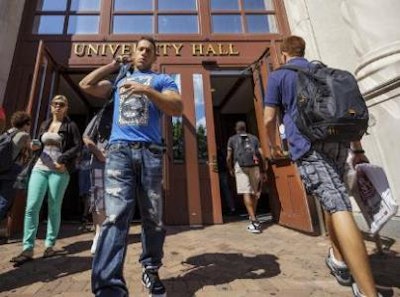
Of the many findings in the report, titled “Transfer & Mobility: A National View of Student Movement in Postsecondary Institutions, Fall 2008 Cohort,” one that jumps out is the large extent to which community colleges are actually a destination — and not merely a departure point — for students who transfer from one institution to another.
“Two-year public institutions are the top mobility destination for students who start in four-year institutions,” the report states. “More than half (51.3 percent) of those transferring from a four-year public institution moved to a two-year public institution.
“Over 40 percent of those who transferred from four-year private institutions headed to community colleges.”
Michelle Asha Cooper, president at the Institute for Higher Education Policy (IHEP), said the fact that community college is a top destination for four-year students suggests that community colleges are fulfilling student needs that are apparently not being met at their respective four-year institutions.
“As soon as I saw that, it said to me one of two things,” Cooper said. “One is they [students] can’t afford to stay in a four-year institution, or the four-year institutions may not have the right types of support, so they then go to a two-year institution to have more flexibility, different classes and things like that.
“On a policy level, we do have to ask ourselves some questions around affordability and institutional support,” Cooper said, “that, to me, this report highlights as possible indicators as to why these patterns are so pronounced.”
Other findings from the report include:
• Mixed enrollment students — that is to say, those who enrolled both full and part time at varying points — had the highest transfer and mobility rates at 53.7 percent. “Changing institutions and changing enrollment statuses both appear to be strategies that students employ in reaction to their changing circumstances,” the report states.
• A quarter of all student mobility from four-year institutions to community colleges consisted of “summer swirlers,” or students who returned to their starting institution the following fall. “This strategy was found, in an earlier Clearinghouse report, to be correlated to higher degree completion rates at the starting four-year institution,” the report states.
• Exclusively part-time students, who the report says are “typically more geographically constrained and most likely to stop out of college altogether,” had the lowest transfer rate at 11.9 percent.
• Out-of-state transfers are a frequent feature of student mobility. “Nearly one in five transfers among students who started in two-year public institutions, and nearly a quarter of transfers from four-year public institutions, occurred across state lines,” the report states.
• Among first-time students who started at a two-year public institution, 24.4 percent transferred to a four-year institution and another 15 percent moved to another two-year institution.
Matthew M. Chingos, a senior fellow and research director at the Brown Center on Education Policy at the Brookings Institution, said the report’s findings “reinforce the need for some degree of standardization of core courses across institutions, so that students can move across institutions without losing credit for work they have completed.”
Chingos said the report also shows the need for a federal unit-record data system “so that policymakers can understand the implications of student transfers for the delivery of student aid and other public programs.”
The report notes that, while nearly a quarter of the students who started at a community college transferred to a four-year institution within six years, only 3.2 percent of the cohort — or roughly 1 in 8 of those who transferred — did so after receiving a credential from the institution where they began.
“The vast majority transferred without a degree,” the report states, noting that a higher proportion of students than previously are transferring without a degree.
“The higher proportion of students transferring without an associate’s degree may create a growing case for reverse transfer initiatives currently being pursued in many states,” the report states. “These initiatives facilitate the transfer of student credits back to two-year institutions that may be able to award a degree.”
But Cliff Adelman, a senior associate at IHEP, expressed skepticism about that approach.
“Technically, what has been called ‘reverse transfer’ since the dawn of recorded history is the four-year beginning student who subsequently changes venue to a two-year institution,” Adelman said in an email to Diverse. “Lately, however, it’s been used to describe credit kickbacks for existing four-year college students so as [potentially] to get them awarded associate degrees from the community college from which they transferred.
“We tried this with four pairs of institutions in Project Win-Win [from 2009 to 2013], and it doesn’t really work,” Adelman said of his prior work. Among other things, Adelman concluded that Project Win-Win — an initiative to retroactively award associate degrees to students who were qualified for the degrees but never got them, or re-enrolling students who were within “striking distance” of an associate degree — would not measurably increase the proportion of the young adult population with degrees.
Jamaal Abdul-Alim can be reached at [email protected] or follow him on Twitter @dcwriter360.





















